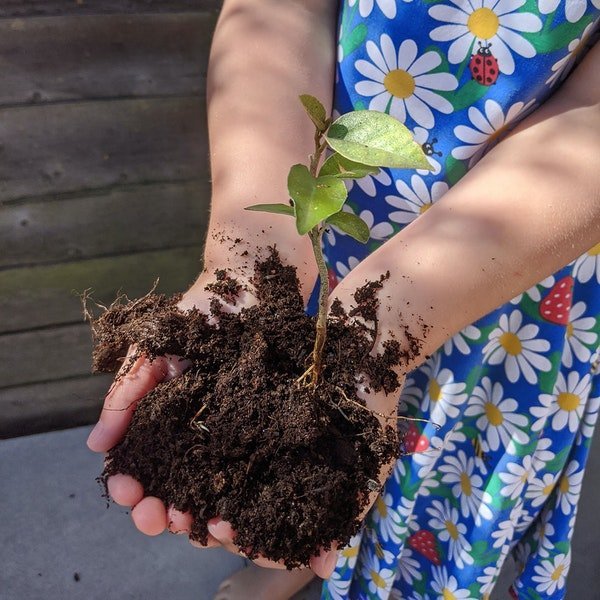
Let’s get kids gardening!
Share

Fine motor skills are enhanced in the garden – think how pulling up weeds and carefully looking after seedlings and plants will help your little ones develop. Kids will also love getting their hands mucky, and exploring the garden engages all our senses. It's even thought to be a great way to help keep our immune systems healthy!
Get your little ones to run the soil between their fingers. Ask them how it feels. Add a bit of water, and how does it feel now? Try making some mud art or mud prints with your mucky hands. Just take a piece of cardboard into the garden and see what your little ones can create!
Herbs are a great way to appeal to kids when it comes to growing and nurturing life in the garden. Start off with mint, and you can all enjoy the results with homemade lemonade, added to an ice-cream treat or sprinkled on top of strawberries. Yum!
You’ll need:
-Peat-free compost
-Plant pot
-Mint plant
-Recycled plastic bag
-Elastic band/bobble
Add compost to the pot, leaving an inch at the top. Make small holes around the edge of the container using a pencil.
Cut 4 or 5 stems of your mint, removing the leaves at the bottom (save them for cooking!) and add them to the holes.
Give it a good water, cover with the bag and fix in place using the band/bobble.
Place your pot somewhere warm and light – let your little ones choose a good spot – and keep the soil nice and moist.
Once the mint has established, you can remove the plastic bag and enjoy your mint!
Your child will be delighted they’ve helped to grow food. You can try it with veg and fruits – particularly if they can be a bit picky with their food. It may encourage them to try and enjoy new healthy foods if they're in charge of growing it!


FAQs: Gardening for Kids
1. What are some easy plants to grow with kids?
- Easy plants for kids to grow include sunflowers, strawberries, tomatoes, lettuce, and radishes. These plants are generally resilient, quick to germinate, and offer visible results, keeping kids engaged and excited about gardening.
2. How can I make gardening fun for my kids?
- To make gardening enjoyable for kids, involve them in choosing plants, creating a kid-friendly garden space, providing child-sized tools, incorporating fun activities like scavenger hunts or creating garden art, and celebrating their accomplishments with rewards or praise.
3. What are the benefits of gardening for children?
- Gardening offers numerous benefits for children, including promoting physical activity, teaching responsibility and patience, fostering a connection with nature, encouraging healthy eating habits, enhancing sensory experiences, and boosting self-confidence and problem-solving skills.
4. How can I teach my child about sustainability through gardening?
- You can teach children about sustainability by explaining concepts such as composting, water conservation, organic gardening practices, and the importance of biodiversity. Engage them in discussions about reducing waste, recycling materials for garden projects, and supporting pollinators like bees and butterflies.
5. Are there any safety precautions I should take when gardening with kids?
- When gardening with kids, it's important to teach them about plant safety, such as not touching or eating unfamiliar plants without adult supervision. Additionally, supervise the use of gardening tools, ensure proper sun protection, and be mindful of potential hazards like sharp objects or thorny plants.
6. How do I maintain my child's interest in gardening over time?
- To sustain your child's interest in gardening, involve them in planning new projects or trying different plants, encourage experimentation and exploration, create opportunities for them to share their gardening experiences with others, and provide ongoing encouragement and support for their efforts.
7. What if I don't have a garden? Can my child still garden?
- Absolutely! Even without a garden, children can still enjoy gardening activities by planting in containers, window boxes, or indoor pots. Consider exploring community gardens or volunteering at local green spaces to provide opportunities for hands-on gardening experiences.
8. How can I incorporate educational aspects into gardening for my child?
- You can integrate various educational elements into gardening by discussing plant life cycles, teaching basic botany concepts, exploring topics such as photosynthesis and pollination, incorporating math through measuring and counting plants, and encouraging journaling or drawing to document observations and discoveries.






